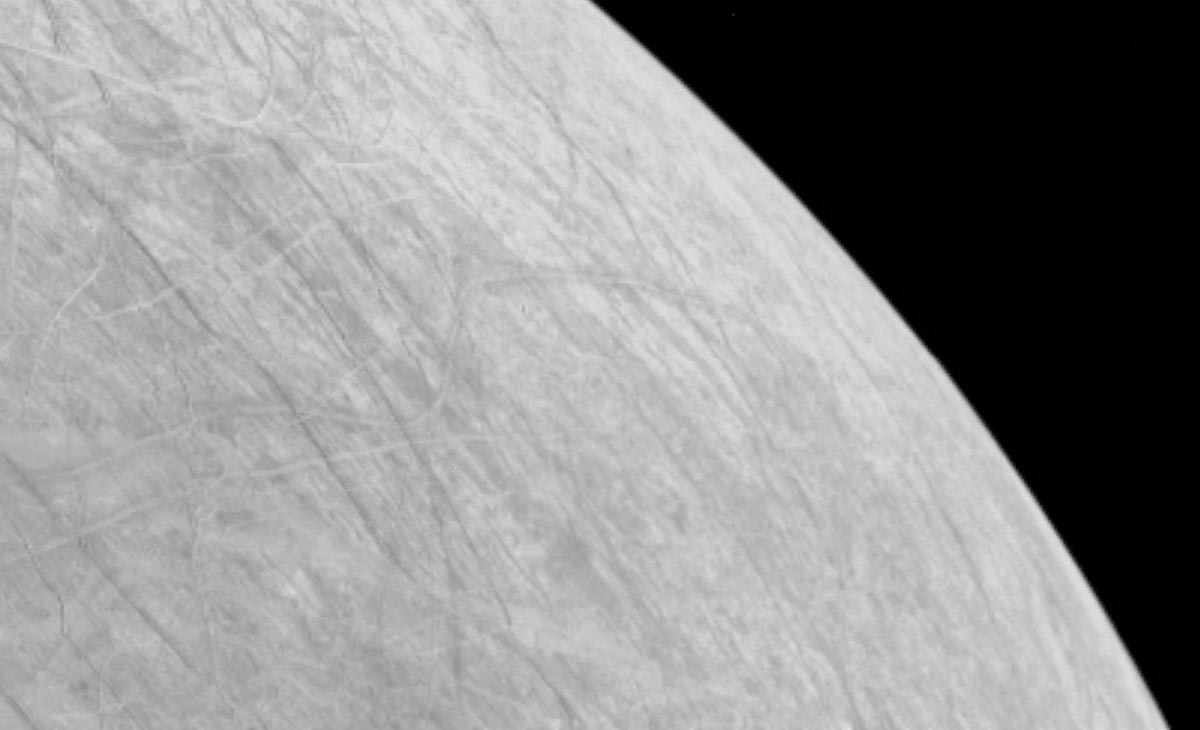
El 29 de septiembre de 2022, la nave espacial Juno de la NASA capturó la compleja superficie cubierta de hielo de la luna Europa de Júpiter durante un sobrevuelo cercano. Crédito: NASA/JPL-Caltech/SWRI/MSSS
Las observaciones del sobrevuelo de la luna helada de la nave espacial Juno fueron los primeros primeros planos de este mundo oceánico en más de dos décadas, lo que resultó en imágenes notables y ciencia única.
El país ya ha recibido la primera imagen.[{» attribute=»»>NASA’s Juno spacecraft captured as it performed a close flyby of Jupiter’s ice-encrusted moon Europa. The image was taken on Thursday, September 29, at 2:36 a.m. PDT (5:36 a.m. EDT), at a distance of about 219 miles (352 kilometers) during the solar-powered spacecraft’s closest approach. It reveals surface features in a region called Annwn Regio near the moon’s equator.
This is only the third close pass of Europa in history below 310 miles (500 kilometers) altitude. In fact, it is the closest look any spacecraft has provided at Europa since NASA’s Galileo came within 218 miles (351 kilometers) of the surface in January 3, 2000.
Slightly smaller than Earth’s moon, Europa is the sixth-largest moon in the solar system. Researchers have uncovered evidence that a salty ocean lies below a miles-thick ice shell, prompting questions about potential conditions capable of supporting life beneath Europa’s surface.
This segment of the first image of Europa captured during this flyby by the spacecraft’s JunoCam zooms in on a swath of Europa’s surface north of the equator. Rugged terrain features are easily seen, due to the enhanced contrast between light and shadow seen along the terminator (the nightside boundary). These include tall shadow-casting blocks, while bright and dark ridges and troughs curve across the surface. Astronomers think the oblong pit seen near the terminator might be a degraded impact crater.

The complex, ice-covered surface of Jupiter’s moon Europa was captured by NASA’s Juno spacecraft during a flyby on September 29, 2022. At closest approach, the spacecraft came within a distance of about 219 miles (352 kilometers). Credit: NASA/JPL-Caltech/SWRI/MSSS
With this additional data about Europa’s geology, Juno’s observations will benefit future missions to the Jovian moon, including NASA’s Europa Clipper. That mission, set to launch in 2024, will study Europa’s atmosphere, surface, and interior. Its main science goal will be to determine whether there are locations below the moon’s surface that could support life.
As exhilarating as Juno’s data will be, the spacecraft had only a two-hour window to collect it. At the time it was racing past the moon with a relative velocity of about 14.7 miles per second (23.6 kilometers per second) or 53,000 miles per hour (85,000 kilometers per hour).
“It’s very early in the process, but by all indications, Juno’s flyby of Europa was a great success,” said Scott Bolton. He is the Juno principal investigator from Southwest Research Institute in San Antonio. “This first picture is just a glimpse of the remarkable new science to come from Juno’s entire suite of instruments and sensors that acquired data as we skimmed over the moon’s icy crust.”
During the flyby, the mission obtained what will be some of the highest-resolution images of the moon (0.6 miles, or 1 kilometer, per pixel). It also gathered valuable data on Europa’s ice shell structure, surface composition, interior, and ionosphere. In addition, it collected useful data on the moon’s interaction with Jupiter’s magnetosphere.
“The science team will be comparing the full set of images obtained by Juno with images from previous missions, looking to see if Europa’s surface features have changed over the past two decades,” said Candy Hansen. She is a Juno co-investigator who leads planning for the camera at the Planetary Science Institute in Tucson, Arizona. “The JunoCam images will fill in the current geologic map, replacing existing low-resolution coverage of the area.”
Juno’s close-up views and data from its Microwave Radiometer (MWR) instrument, a multi-wavelength microwave radiometer, will provide new details on how the structure of Europa’s ice varies beneath its crust. With all this information, scientists will be able to generate new insights into the moon, including data in the search for regions where liquid water may exist in shallow subsurface pockets.
NASA’s Europa Clipper mission will build on Juno’s observations and previous missions such as Voyager 2 and Galileo. It is scheduled to arrive at Europa in 2030 and will study the moon’s atmosphere, surface, and interior. The mission’s goal is to investigate habitability and better understand its global subsurface ocean and the thickness of its ice crust. It will also search for possible plumes that may be venting subsurface water into space.
The gravitational forces from this close flyby modified Juno’s trajectory, reducing the time it takes to orbit Jupiter from 43 to 38 days. The flyby also marks the second encounter with a Galilean moon during Juno’s extended mission. The mission explored Ganymede, the largest moon in the solar system, in June 2021. It is scheduled to make close flybys of Jupiter’s innermost moon Io, the most volcanic body in the solar system, in 2023 and 2024.
More About the Mission
NASA’s Jet Propulsion Laboratory (JPL), a division of Caltech in Pasadena, California, manages the Juno mission for the principal investigator, Scott J. Bolton, of the Southwest Research Institute in San Antonio. Juno is part of NASA’s New Frontiers Program, which is managed at NASA’s Marshall Space Flight Center in Huntsville, Alabama, for NASA’s Science Mission Directorate in Washington. Lockheed Martin Space in Denver built and operates the spacecraft.

Aficionado a los viajes. Lector exasperantemente humilde. Especialista en internet incurable
 Impulsse.la Complete News World
Impulsse.la Complete News World
